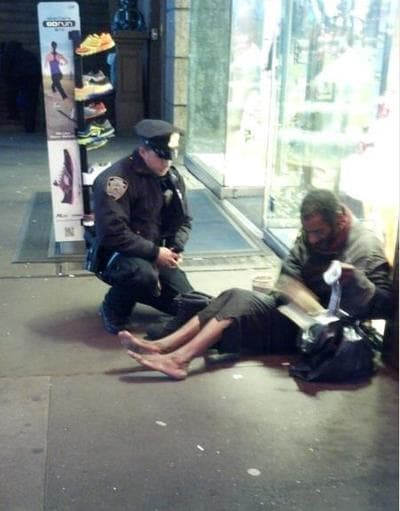Advertisement
Controversial Photos Prompt Ethics Questions

There have been two powerful photographs in the news recently, both stirring up controversy and raising questions about the editorial and ethical decisions faced by editors and photo journalists.
Last week, a photo snapped by a passerby of a policeman giving boots to barefoot homeless man went viral online. It has since come out that the man is not homeless, though he does struggle with housing problems.
Then on Tuesday, the New York Post ran on its cover a photo of a man about to get struck by a subway train. (Caution: The photo is disturbing.) The victim, Ki Suk Han, 58, had been pushed onto the tracks moments before.
The bold, underlined letters printed over the photo read "Pushed on the subway track, this man is about to die," and in larger all-capital letter below, "DOOMED."
The freelance photographer who captured the controversial image, R. Umar Abbasi, defended his decision to photograph the man, instead of helping him, in a story in Wednesday's New York Post.

John Kaplan, professor of photojournalism at the University of Florida and Pulitzer Prize winner for feature photography, told Gawker that "The blame in this controversy lies directly with the New York Post for publishing such a callous, crude and truly tasteless headline while at the same time wrongly splashing the tragedy on the front page."
Kenny Irby, a professor of visual journalism at the Poynter Institute, told Here & Now that most papers have reduced the number of photo editors, so the emphasis on fact checking is not what it used to be.
The news story of the man pushed onto the tracks and killed should be reported on, Irby said, but other photos could have been chosen and the language could have been changed.
This is not the first time that a photojournalist has come under fire for not helping the subject of a photo.
Photographer Stanley Forman was criticized for his 1975 photo, published in The Boston Herald American, of a 2-year-old girl and her 19-year-old godmother falling from a broken fire escape.

The girl survived the fall, but the godmother died from her injuries. Forman won a Pulitzer Prize for the photo in 1976.
South African photojournalist Kevin Carter was blasted in 1993 for not helping the starving toddler he photographed being eyed by a vulture in Sudan.
Carter committed suicide in 1994, shortly after receiving a Pulitzer Prize for the photo.
Would you have printed these photos? What are your thoughts on how editors should weigh whether and how to use a photo? Let us know in the comments section below or on our Facebook page.
Guest:
- Kenny Irby, senior faculty for visual journalism at the Poynter Institute.
This segment aired on December 6, 2012.